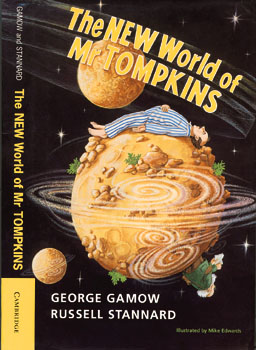by George Gamow and Russell Stannard, Cambridge, ISBN 0 521 63009 6 (hbk £14.95).

George Gamow was a sort of prototype Richard Feynman gifted, incisive, exuberant, unpredictable and occasionally eccentric. Feynman played bongo drums and opened safes, while Gamow preferred conjuring. Born in Russia in 1904, Gamow gradually emigrated westwards via Göttingen, Copenhagen, Cambridge, Paris and London. He eventually moved to the US in 1934. Gamow left a substantial scientific and literary legacy.
After milestone contributions to nuclear physics (which included the GamowTeller coupling), at Göttingen he explained the mystery of alpha radioactivity, showing how quantum tunnelling allowed low-energy particles to escape the pull of the nucleus. When Gamow brought these insights to Cambridge, Rutherford and Cockcroft realized that what goes out can also come in. In a kind of reverse radioactivity, relatively low-energy bombarding particles should be able to enter the nucleus and induce nuclear transformations. From the late 1920s, this motivated the push for particle accelerators.
Working with his student, Ralph Alpher, in Washington in the 1940s, Gamow learned that the young Hans Bethe was visiting the US and invited him to add his name to the famous “Alpher, Bethe, Gamow” papers on the origin of the chemical elements. In the late 1940s, Gamow also helped to develop the ideas that are now known as the Big Bang.
In 1938 he wrote a short science fantasy (being careful not to call it science fiction), in which he tried to explain the ideas of the relativistic curvature of space and the expanding universe. The hero of his story was a modest bank clerk called C G H Tompkins. His initials were borrowed from the standard physics notation for the speed of light, the gravitational constant and Planck’s constant.
After sending the piece to several large circulation magazines and receiving impersonal rejection slips, Gamow put it to one side until his physicist friend, Sir Charles Darwin (the grandson of the author of The Origin of Species), suggested sending it to C P Snow, then the editor of Discovery magazine, published by Cambridge University Press. The text was immediately accepted and the discerning Snow demanded more.
Mr Tompkins tries valiantly to follow dry science lectures, but easily falls asleep. However, all becomes clear in his vivid dreams. Soon the articles were collected into Mr Tompkins in Wonderland, published in 1940, followed by Mr Tompkins Explores the Atom in 1944. Each was a major success and the two volumes were reissued with additional material as a single volume in 1965. This reissue alone was reprinted some 20 times.
Thirty years after this revision, the book was still selling* but was seriously out of date. With Gamow no longer available (he died in 1968), UK physicist Russell Stannard, author of the well-known “Uncle Albert” trilogy (The Time and Space of Uncle Albert, Black Holes and Uncle Albert and Uncle Albert and the Quantum Quest), was invited to give Mr Tompkins a facelift. As well as updating the science to include quarks, the Standard Model and supersymmetry, Stannard has also tried to modernize the text. For example, the title of Gamow’s chapter 10 “The gay tribe of electrons” had acquired another connotation over the years and has become “The merry tribe of electrons”. An additional chapter “Visiting the atom smasher” provides an opportunity to introduce a politically correct female spokesperson (however, she is depicted as unfeminine and wearing a white coat).
Although concepts are gently introduced, ultimately there is little attempt to paraphrase. A 120-entry glossary, extending over 10 pages, has been thoughtfully provided.
Tompkins is a moot figure. Although he no longer exclaims “By jove!”, he seems to have got stuck in a time warp. The original illustrations, revised by Gamow for the 1965 reissue, did have a certain charm. Although the pictures have been redrawn for 1999, the original style remains. Mild-mannered Tompkins is still supposed to be in his 30s but looks like a refugee from a Tintin episode. Already a dweeb in the original version, now he is an anachronism. Perhaps it is time for “The World of the New Mr Tompkins” in “now-speak”, where the Internet exists and where dog-eared flip charts have been discarded in favour of Powerpoint displays.
However, the Tompkins character evokes sympathy, and the impressive literary track record of George Gamow and of Russell Stannard shows that packaging basic physics with a veneer of personification and anecdote via dreams and thought bubbles does work.
*The 1965 reissue is available as Mr Tompkins in paperback by George Gamow, Cambridge, ISBN 0 521 44771 2 (£7.95).








